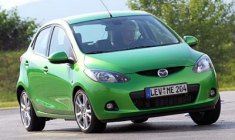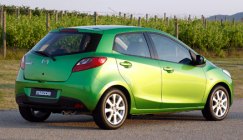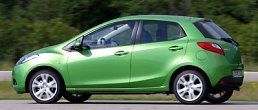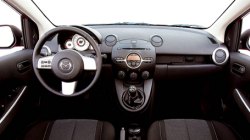|
 For the past 20
years mini cars had been
growing in size and weight in order to provide more space, better crash
protection and higher refinement. The trend was especially worrying in
these two years as we saw the jumbo-size Renault Clio and Peugeot 207.
Getting bigger not only requires more metal, plastic and glass but also
larger engines, transmission and brakes. As a result, new generation of
mini cars cost more money to build, consume more fuel and emit more
carbon dioxide than engineers originally forecasted. Facing tougher
legislation against greenhouse gas emission expected in Europe in the
future, downsizing will become the trend in the next few years.
Surprisingly, leading the trend is not any European car makers, but the
Japanese Mazda. For the past 20
years mini cars had been
growing in size and weight in order to provide more space, better crash
protection and higher refinement. The trend was especially worrying in
these two years as we saw the jumbo-size Renault Clio and Peugeot 207.
Getting bigger not only requires more metal, plastic and glass but also
larger engines, transmission and brakes. As a result, new generation of
mini cars cost more money to build, consume more fuel and emit more
carbon dioxide than engineers originally forecasted. Facing tougher
legislation against greenhouse gas emission expected in Europe in the
future, downsizing will become the trend in the next few years.
Surprisingly, leading the trend is not any European car makers, but the
Japanese Mazda.
 The new
Mazda 2 – or Demio as it is called in Japan – is the first mini car in
recent years to trim size and weight. Compare with the outgoing car, it
is 40 mm shorter, 55 mm lower and the body profile is less boxy.
Mazda's stylists in Tokyo gave it a sharp and sporty appearance, a
complete change of character from the functional-biased old car.
Whether it looks beautiful is another matter. I'll let you make the
judgment. However, the most important is a weight reduction of 100
kilograms from the old car. This is contributed by the reduced size,
the use of more high-tensile steel, the all-alloy new engines, the
switch from hydraulic to electric power steering and the use of simpler
folding rear seat. Tipping the scale at only 960 kg, the new Mazda 2 is
probably the first sub-1-ton car of its class since Mitsubishi Colt
arrived 3 years ago. The new
Mazda 2 – or Demio as it is called in Japan – is the first mini car in
recent years to trim size and weight. Compare with the outgoing car, it
is 40 mm shorter, 55 mm lower and the body profile is less boxy.
Mazda's stylists in Tokyo gave it a sharp and sporty appearance, a
complete change of character from the functional-biased old car.
Whether it looks beautiful is another matter. I'll let you make the
judgment. However, the most important is a weight reduction of 100
kilograms from the old car. This is contributed by the reduced size,
the use of more high-tensile steel, the all-alloy new engines, the
switch from hydraulic to electric power steering and the use of simpler
folding rear seat. Tipping the scale at only 960 kg, the new Mazda 2 is
probably the first sub-1-ton car of its class since Mitsubishi Colt
arrived 3 years ago.
 Modern
mini cars have generally the same drivetrain and suspension format.
Mazda 2 can't escape from this formula. However, the new found
lightweight gives it an agile handling and brisk performance lacking in
most rivals. It attacks corner with enthusiasm. Its steering might be
light and short of feel (as in most electrical setup), but it is quick
and precise. A compliant ride and fine body control implies good
suspension tuning. The 5-speed gearbox has a slick gearshift. The
1.5-liter engine with inlet VVT, variable length intake manifold and
swirl control valves pulls sweetly across the rev and make the car
feels faster than figures suggested. Although the 1.5 engine sounds a
little coarse at high rev, it isn't intrusive to the occupants, thanks
to the effective sound insulation. In terms of refinement, the new
Mazda 2 not only suffers nothing from the weight reduction, but it even
improves noticeably from its predecessor. The chassis feels rigid and
isolates NVH very well. You can even expect a 5-star Euro NCAP crash
rating. Modern
mini cars have generally the same drivetrain and suspension format.
Mazda 2 can't escape from this formula. However, the new found
lightweight gives it an agile handling and brisk performance lacking in
most rivals. It attacks corner with enthusiasm. Its steering might be
light and short of feel (as in most electrical setup), but it is quick
and precise. A compliant ride and fine body control implies good
suspension tuning. The 5-speed gearbox has a slick gearshift. The
1.5-liter engine with inlet VVT, variable length intake manifold and
swirl control valves pulls sweetly across the rev and make the car
feels faster than figures suggested. Although the 1.5 engine sounds a
little coarse at high rev, it isn't intrusive to the occupants, thanks
to the effective sound insulation. In terms of refinement, the new
Mazda 2 not only suffers nothing from the weight reduction, but it even
improves noticeably from its predecessor. The chassis feels rigid and
isolates NVH very well. You can even expect a 5-star Euro NCAP crash
rating.
 Inside, cabin space is not compromised by the reduced size,
because the wheelbase is unchanged and the faster windscreen and
tailgate eat no usable space. This mean it can accommodate four
six-footers plus a decent boot of 250 liters. Thanks to the low waist
line near the A-pillars, the cabin feels light and airy. On the
downside, the dashboard is made of low rent hard plastic. It has none
of the quality feel of Renault Clio, Opel Corsa or even Peugeot 207 and
Fiat Grande Punto. That's about its biggest weakness. Inside, cabin space is not compromised by the reduced size,
because the wheelbase is unchanged and the faster windscreen and
tailgate eat no usable space. This mean it can accommodate four
six-footers plus a decent boot of 250 liters. Thanks to the low waist
line near the A-pillars, the cabin feels light and airy. On the
downside, the dashboard is made of low rent hard plastic. It has none
of the quality feel of Renault Clio, Opel Corsa or even Peugeot 207 and
Fiat Grande Punto. That's about its biggest weakness.
The days for substantial mini cars are numbered. Mazda 2 demonstrates
that by downsizing and clever use of weight and space, a mini car can
achieve higher level of driving fun without hurting practicality and
driving refinement. Better still, it returns lower fuel consumption and
emission* and contribute a little to our greener future. No wonder
Mazda chose a green car to feature in press release photosgraphs.
* Remark: a 1.5-liter
Mazda
2
returns 48 mpg for EU combined cycle and emit 140 grams of CO2 per km.
A comparable Renault Clio returns 43 mpg and 157g/km of CO2.
|